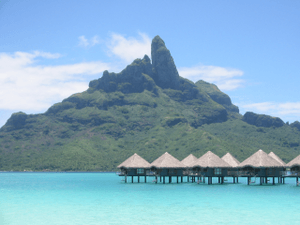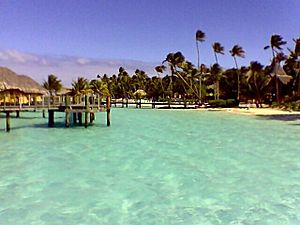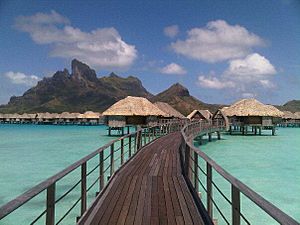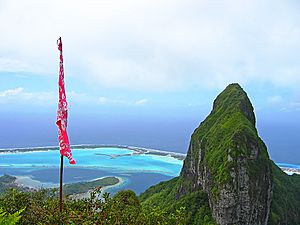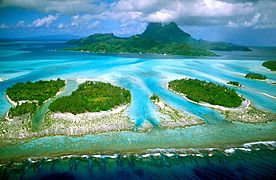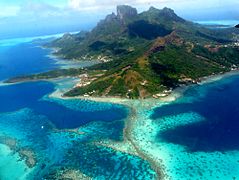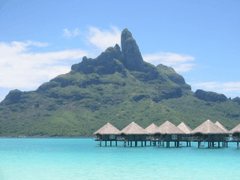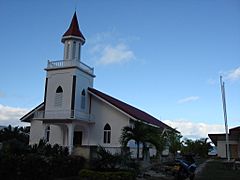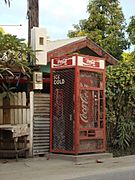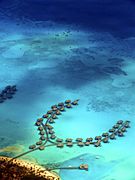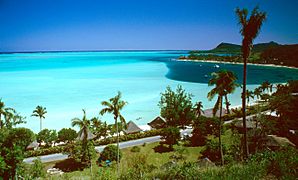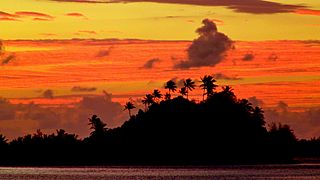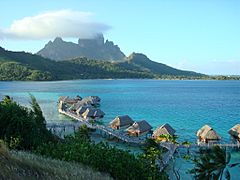Bora Bora facts for kids
Quick facts for kids
Bora-Bora
|
|
|---|---|
| Country | France |
| Overseas collectivity | French Polynesia |
| Associated communes | Anau, Faanui, Vaitape |
| Area | 40.3 km2 (15.6 sq mi) |
| Population
(2012)
|
9,690 |
| • Density | 240.4/km2 (622.8/sq mi) |
| INSEE/Postal code |
98714 /98730
|
| Elevation | 0–727 m (0–2,385 ft) |
Bora Bora is a small, beautiful island in the Pacific Ocean. It is part of French Polynesia, which is an overseas territory of France. Bora Bora belongs to the Leeward group of the Society Islands.
The biggest town on the island is Vaitape, where about 4,000 people live. There is also an airport on a small island nearby. From here, people can fly to other islands in French Polynesia. Bora Bora has one main road that goes all the way around the island.
Contents
People of Bora Bora
About 9,690 people live permanently on Bora Bora and its nearby islands.
What's in a Name?
Long ago, the island was called "Pora pora mai te pora." This means "created by the gods" in the local Tahitian language. People often shortened it to Pora Pora, which simply means first born.
Because of how the Tahitian language sounds, "Pora Pora" could also be heard as "Bola Bola" or "Bora Bora." When the explorer Jacob Roggeveen first arrived in 1722, he and his crew started using the name Bora Bora. That name has stuck ever since!
Island History
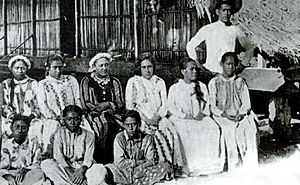
Polynesian people first settled on Bora Bora around the 4th century C.E. The first European to see the island was Jacob Roggeveen in 1722. Later, James Cook saw the island in 1769 and landed there that same year. He had a skilled navigator named Tupaia with him.
Christian missionaries from the London Missionary Society arrived in 1820. They started a Protestant church in 1890. Bora Bora was its own independent kingdom for a long time. But in 1888, its last queen, Teriimaevarua III, had to give up her rule. France then took over the island as a colony.
Bora Bora in World War II
During World War II, the United States chose Bora Bora as an important military base. It was used to store supplies in the South Pacific. They built an airstrip, a place for seaplanes, and strong defenses. This project was called "Operation Bobcat."
The base had nine ships, 20,000 tons of equipment, and nearly 7,000 soldiers. Seven large artillery guns were placed around the island to protect it. However, there was no fighting on Bora Bora during the war. The American presence was never challenged.
The base officially closed on June 2, 1946. The airstrip built during the war was too small for large planes. But it was French Polynesia's only international airport until 1960. That's when Faa'a International Airport opened near Papeete, Tahiti.
Bora Bora's Government
The area known as the commune of Bora-Bora includes the main island and many small islands around its coral reef. These small islands are called motu. Some of them are Motu Tapu, Motu Ahuna, and Motu Mute.
The commune also includes the atoll of Tupai, which is about 20 kilometers (12 miles) north of Bora Bora. An atoll is a ring-shaped coral reef with a lagoon in the middle. Tupai does not have many permanent residents. Only about 50 workers live there to tend to coconut plantations.
Bora Bora is an administrative division of the Leeward Islands. It includes three main areas:
- Anau
- Faanui
- Vaitape
The main government office for the commune is in Vaitape. The current mayor of Bora Bora is Édouard Fritch. He is also the President of French Polynesia.
Visiting Bora Bora
Tourism is the main way Bora Bora makes money. Many fancy resorts have been built on the small islands (motu) around the main lagoon. The Hotel Bora Bora opened in 1961. Nine years later, it built the first over-the-water bungalows. These are small houses built on stilts over the water.
Today, over-water bungalows are a common sight at most resorts in Bora Bora. You can find bungalows that are simple and affordable, or very luxurious and expensive.
Most tourist activities involve the water. However, you can also visit places on land, like old World War II cannons. Air Tahiti has several flights each day to the Bora Bora Airport on Motu Mute. These flights come from Tahiti and other islands.
There is no public transportation on the island. So, it's best to rent cars or bicycles to get around. You can also rent small, two-seater buggies in Vaitape. Renting a motorboat is a fun way to explore the lagoon.
Snorkeling and scuba diving are very popular activities in Bora Bora's lagoon. Many types of sharks and rays live in the waters around the island. Some dive companies offer special tours to see manta rays or even feed sharks.
A new man-made island called Motu Marfo has been added in the lagoon. It is part of the St. Regis Resort.
Bora Bora's Weather
Most of the rain in Bora Bora falls during the summer months, from November to April. This time of year also has high humidity. However, you can still find clear, sunny days even in the middle of January.
Gallery
Images for kids
-
Teriimaevarua III, last Queen of Bora Bora
-
Blacktip reef shark (Carcharhinus melanopterus) at Bora Bora
See also
 In Spanish: Bora Bora (atolón) para niños
In Spanish: Bora Bora (atolón) para niños


